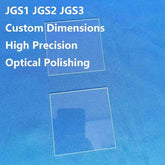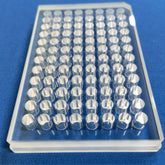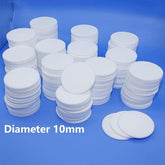Comparative Analysis of Quartz Windows versus Alternative Materials
1. Quartz plates
The primary component of quartz plates is silicon dioxide (SiO2), with high-purity crystal containing up to 99.99% SiO2. It exhibits inherent colorlessness and exceptional SiO2 purity.
Advantages: It features high hardness and is resistant to abrasion.
Disadvantages: It is incapable of absorbing short-wave ultraviolet rays, and its rarity contributes to its high expense.

2. Glass plates
Glass plates are classified as optical glass and are subject to rigorous quality requirements, including parameters such as refractive index, dispersion, and transmittance. The primary component is silicon dioxide (SiO2), followed by boron trioxide (B2O3) and phosphorus pentoxide (P2O5).
Advantages: It boasts excellent hardness and is comparable to that of crystal. After being mixed with various oxides, it can be coloured, thus not only reducing stimulation from strong light but also absorbing harmful rays such as ultraviolet and infrared light.
Disadvantages: It is heavy, with a specific gravity that is double that of resin materials. As the refractive index rises, the specific gravity increases substantially. Its impact resistance is inadequate and it is susceptible to mechanical damage. Consequently, its safety is relatively poor. For almost one hundred years, there has been a continuing search for alternative materials that are superior.

3. Resin plates
Resin plates are composed of organic substances, primarily carbon, hydrogen, nitrogen and oxygen. The resin material must be uniform in texture, transparent and not prone to deformation. The most commonly used types at present are as follows.
(1) Polymethylmethacrylate (PMMA): Its refractive index is 1.49, its dispersion is 58, and its specific gravity is 1.19.
Advantages: It is characterized by its low weight, which is half that of glass. It exhibits adequate impact resistance and is considered to be safe.
Disadvantages: It is a thermoplastic material that is susceptible to deformation when subjected to high temperatures. The surface hardness is inadequate and the wear resistance is insufficient.
(2) Propylene carbonate acetic acid (CR-39)
It is a petroleum extract, its refractive index is 1.4985, Abb number is 57.8, and specific gravity is 1.32.
Advantages: It is lightweight, safe and has good impact resistance. It is UV-resistant and can fully block ultraviolet rays below 350mm. Its ease of dyeing, facilitated by modern casting technology, allows for efficient mass production.

Disadvantages: It exhibits inadequate wear resistance. The refractive index is reduced, and the appearance is thickened.
(3) Polycarbonate (PC): It is formed by the polymerization of flexible carbonate rings and immovable bisphenol A. Its molecular weight is between 20,000 and 38,000, and its refractive index is 1.586 under the test condition of 25℃.
Advantages: It is characterized by its remarkable lightness, which is significantly more than that of traditional glass plates. Furthermore, it is a safe material and has 60 times the impact resistance of glass. When the thickness is 2.5cm, it can be used as bullet-proof glass.
Disadvantages: It exhibits inadequate wear resistance.






